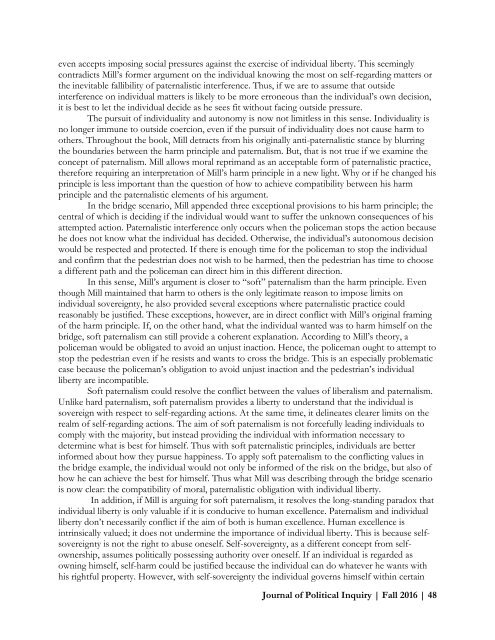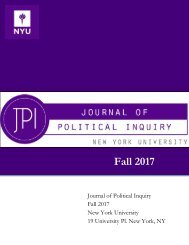Fall2016_Final2
You also want an ePaper? Increase the reach of your titles
YUMPU automatically turns print PDFs into web optimized ePapers that Google loves.
even accepts imposing social pressures against the exercise of individual liberty. This seemingly<br />
contradicts Mill’s former argument on the individual knowing the most on self-regarding matters or<br />
the inevitable fallibility of paternalistic interference. Thus, if we are to assume that outside<br />
interference on individual matters is likely to be more erroneous than the individual’s own decision,<br />
it is best to let the individual decide as he sees fit without facing outside pressure.<br />
The pursuit of individuality and autonomy is now not limitless in this sense. Individuality is<br />
no longer immune to outside coercion, even if the pursuit of individuality does not cause harm to<br />
others. Throughout the book, Mill detracts from his originally anti-paternalistic stance by blurring<br />
the boundaries between the harm principle and paternalism. But, that is not true if we examine the<br />
concept of paternalism. Mill allows moral reprimand as an acceptable form of paternalistic practice,<br />
therefore requiring an interpretation of Mill’s harm principle in a new light. Why or if he changed his<br />
principle is less important than the question of how to achieve compatibility between his harm<br />
principle and the paternalistic elements of his argument.<br />
In the bridge scenario, Mill appended three exceptional provisions to his harm principle; the<br />
central of which is deciding if the individual would want to suffer the unknown consequences of his<br />
attempted action. Paternalistic interference only occurs when the policeman stops the action because<br />
he does not know what the individual has decided. Otherwise, the individual’s autonomous decision<br />
would be respected and protected. If there is enough time for the policeman to stop the individual<br />
and confirm that the pedestrian does not wish to be harmed, then the pedestrian has time to choose<br />
a different path and the policeman can direct him in this different direction.<br />
In this sense, Mill’s argument is closer to “soft” paternalism than the harm principle. Even<br />
though Mill maintained that harm to others is the only legitimate reason to impose limits on<br />
individual sovereignty, he also provided several exceptions where paternalistic practice could<br />
reasonably be justified. These exceptions, however, are in direct conflict with Mill’s original framing<br />
of the harm principle. If, on the other hand, what the individual wanted was to harm himself on the<br />
bridge, soft paternalism can still provide a coherent explanation. According to Mill’s theory, a<br />
policeman would be obligated to avoid an unjust inaction. Hence, the policeman ought to attempt to<br />
stop the pedestrian even if he resists and wants to cross the bridge. This is an especially problematic<br />
case because the policeman’s obligation to avoid unjust inaction and the pedestrian’s individual<br />
liberty are incompatible.<br />
Soft paternalism could resolve the conflict between the values of liberalism and paternalism.<br />
Unlike hard paternalism, soft paternalism provides a liberty to understand that the individual is<br />
sovereign with respect to self-regarding actions. At the same time, it delineates clearer limits on the<br />
realm of self-regarding actions. The aim of soft paternalism is not forcefully leading individuals to<br />
comply with the majority, but instead providing the individual with information necessary to<br />
determine what is best for himself. Thus with soft paternalistic principles, individuals are better<br />
informed about how they pursue happiness. To apply soft paternalism to the conflicting values in<br />
the bridge example, the individual would not only be informed of the risk on the bridge, but also of<br />
how he can achieve the best for himself. Thus what Mill was describing through the bridge scenario<br />
is now clear: the compatibility of moral, paternalistic obligation with individual liberty.<br />
In addition, if Mill is arguing for soft paternalism, it resolves the long-standing paradox that<br />
individual liberty is only valuable if it is conducive to human excellence. Paternalism and individual<br />
liberty don’t necessarily conflict if the aim of both is human excellence. Human excellence is<br />
intrinsically valued; it does not undermine the importance of individual liberty. This is because selfsovereignty<br />
is not the right to abuse oneself. Self-sovereignty, as a different concept from selfownership,<br />
assumes politically possessing authority over oneself. If an individual is regarded as<br />
owning himself, self-harm could be justified because the individual can do whatever he wants with<br />
his rightful property. However, with self-sovereignty the individual governs himself within certain<br />
Journal of Political Inquiry | Fall 2016 | 48
















